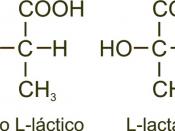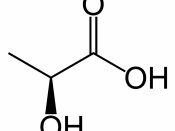Exercise Physiology
In researching for my paper I now know why you gave us so much flexibility on what are topic could be. In explaining lactic acid and exercise I am forced to dive into many other areas pertaining to the last few chapters that we have been covering in class. In other words, you are right, this is a good form of studying because exercise physiology is one of those things were you can not understand one part with out understanding the surrounding parts that lead up to what you are focusing on.
With that in mind I will begin with explaining how lactic acid is formed. I like to think of it, while wait, I really don't like to think of it, but anyway, the build up of lactic acid is just that; a build up in the electron transport chain. "The body has a limited store of about 85g of ATP and would use it up very fast if we were unable to resynthesis.
As we exercise pyruvate is formed. When insufficient oxygen is available to breakdown the pyruvate then lactate is produced. Lactate enters the surrounding muscle cells, tissue and blood. The muscle cells and tissues receiving the lactate either breakdown the lactate to fuel (ATP) for immediate use or use it in the creation of glycogen. The glycogen then remains in the cells until energy is required. 65% of lactic acid is converted to carbon dioxide and water, 20% into glycogen, 10% into protein and 5% into glucose." (resource#2) Okay, so that is all fine and dandy but what exactly does it mean. Lactic acid gives the body the ability to reproduce ATP with no oxygen. It derives the oxygen needed for energy from a process called anaerobic glycolysis. Glycolysis refers to the breakdown of...



Good
Good paper. It explains the process well. It's written in a very talkative style, which can be good. I think the intro and conclusion could use some more "meat".
0 out of 0 people found this comment useful.